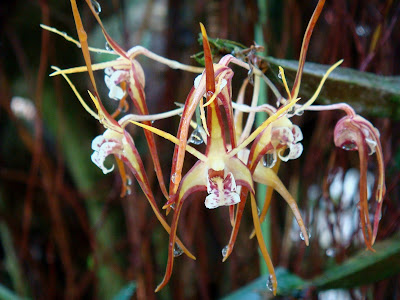Dendrobium tetragonum is native to the Southeast Australia. Their natural habitat extends from the areas south of Sydney to the Brisbane area in the north. Usually they are found close to the coast, but sometimes they are found growing on the low eastern slopes of the Dividing Range around 100 km inland...
Dendrobium tetragonum also called as The Rectangular-Bulbed Dendrobium, The Blotched Tree Spider Orchid, The Banded Tree Spider Orchid, Callista tetragona, Dendrobium capitisyork, Dendrobium tetragonum subsp. cataractarum, Dendrobium tetragonum subsp. giganteum, Dendrobium tetragonum var. giganteum, Dendrobium tetragonum var. giganteum, Dendrobium tetragonum var. hayesianum, Dendrobium tetragonum var. serpentis, Dendrobium tetragonum var. tomentosum, Dendrobium tetragonum var. variabilis, Dendrocoryne tetragonum, Tetrabaculum capitisyork, Tetrabaculum tetragonum, Tropilis tetragona, Tropilis tetragona, is a species of the genus Dendrobium. This species was described by Allan Cunningham ex John Lindley in 1839.
IDENTIFY DENDROBIUM TETRAGONUM
Dendrobium tetragonum is native to the Southeast Australia. Their natural habitat extends from the areas south of Sydney to the Brisbane area in the north. Usually they are found close to the coast, but sometimes they are found growing on the low eastern slopes of the Dividing Range around 100 km inland. Occasionally, they are found even at the heights of about 1000 m, but usually grow much lower. In the northern (warmer) part of the natural habitat they rarely grow above 500 m. They are generally found in damp, shady areas with strong air movement, such as ravines and steam. They also grow on trees in rainforests, near swamps and along mountain valleys.
It is a cool to warm growing, small to medium sized, epiphytic species, which reaching 5-50 cm in height, with semi-pendulous, clustered, 4 angled, widest at the middle, spindle shaped apically, from 7 to 10 noded, 5-10 cm long, but can reach a length of up to 50 cm long stems carrying 2 to 3, ovate or oblong, acute, papery thin yet coriaceous, dark green, 3-10 cm long leaves.
The Rectangular-Bulbed Dendrobium blooms in fall till spring on a very short, raceme with minute floral bracts and 1 to 5, variable shaped, very fragrant flowers that arise from near the apex of the leafed cane. The inflorescence can rebloom over several flowering periods so do not remove any old inflorescence, also the nodes on the thickened area of the pseudobulb can generate inflorescence. The flowers are small and only 4 cm long, but they are usually larger and even exceed 12 cm. The outer whorls are yellow-green with red, brown or purple edges with variable width. The smaller petals of the inner whorl are pale yellow-green and very slender. All elements of the flower are narrowing to form sharp tips. The lip may be white or pale yellow with red markings and its tip is sharp and curved. A single flower lasts for 10-20 days, but more flowers can grow for several months.
DENDROBIUM TETRAGONUM CARE AND CULTURE
Cultural information should only be used as a guide, and should be to be adapted to suit you. Your physical location; where you grow your plants, how much time you have to devote to their care, and many other factors, will need to be taken into account. Only then can you decide on the cultural methods that best suit you and your plants.
Light:
Dendrobium tetragonum needs a light level of 15000-30000 lux. It is recommended 60% shading and strong air movement.
Temperature:
It is a plant with moderate thermal requirements. The average temperature of the summer day is 25 ° C, the night 15-17 ° C, which gives a daily difference of 8-10 ° C. The average temperature of the winter day is 17-20 ° C, and the winter night is 5-8 ° C, giving a daily difference of 12-13 ° C.
Humidity:
The Rectangular-Bulbed Dendrobium needs the humidity of 75-80% for most of the year, falling to around 70% in winter.
Substrate, growing media and repotting:
Mounting on a hardwood or rootstock is preferred due to the overhanging vegetation. It is easy to root rot when the plant is mounted on a tree fern rootstock, because it keeps too much water. The plants should lightly dry between successive waterings. Repotting is best done when new roots are actively growing, but these plants are very retreating in growth if they are violated.
Watering:
Precipitation is moderate to heavy for most of the year, but in the 2-3 winter months the conditions are slightly drier. Dendrobium tetragonum should be kept moist and not allowed to dry completely.
Fertilizer:
A 1/4-1/2 standard dose is recommended every week. High nitrogen fertilizer is beneficial from spring to mid-summer, and then use highly phosphoric fertilizer.
Rest period:
Dendrobium tetragonum should be allowed to dry slightly between waterings, but they can not staying dry too long. Fertilization should be reduced or eliminated whenever the amount of water decreases.















COMMENTS